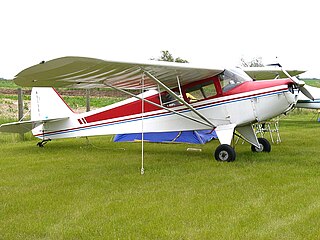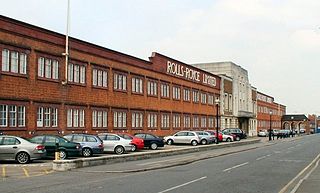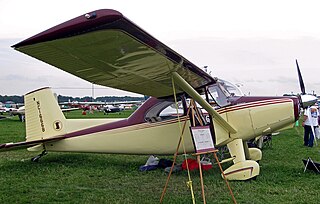 | |
 A Luscombe 8 in Popham, Hampshire | |
| Industry | Aerospace |
|---|---|
| Founded | 1933 |
| Founders | Donald Arthur Luscombe |
| Successor | Temco Aircraft |
Luscombe Aircraft was a United States aircraft manufacturer from 1933 to 1950.
 | |
 A Luscombe 8 in Popham, Hampshire | |
| Industry | Aerospace |
|---|---|
| Founded | 1933 |
| Founders | Donald Arthur Luscombe |
| Successor | Temco Aircraft |
Luscombe Aircraft was a United States aircraft manufacturer from 1933 to 1950.
Donald A. Luscombe founded the Luscombe aircraft company in 1933 in Kansas City, Missouri. Luscombe had already made his reputation as an aircraft designer with the Monocoupe series of light aircraft, but he felt that the tube-and-fabric method of construction was too expensive and inefficient. He planned to create a light aircraft that was all-metal monocoque construction.
The new company's first aircraft was the Luscombe Model 1, commonly known as the Luscombe Phantom. This was a high-wing, two-place monoplane of all-metal construction (except for the fabric wing covering). The Phantom was tricky to land, and was never a financial success.
In the winter of 1934/35, Luscombe Aircraft moved to Trenton, New Jersey, and was incorporated as the Luscombe Aircraft Development Corporation. Shortly afterwards, the Luscombe School of Aeronautics opened. Trainees from the school worked in the Luscombe factory, and the school helped support the aircraft company for many years.
In 1936, the company designed and began flying a simplified version of the Phantom known as the Luscombe 90, or Model 4.
The Luscombe Aircraft Corporation was re-formed as a New Jersey company in 1937, and a new design was begun. The Luscombe 50 (Model 8) became the company's most famous product. The Type Certificate for the Model 8 is A-694 and is now held by Good Earthkeeping Organization, Inc. of Corona, California, USA.
In 1946, Luscombe also introduced the four-place model 11, designed to specifications produced by the Flying Farmers of America.
The firm was bankrupt in 1948 and its assets were purchased the following year by Temco.
As of December 2024 [update] the factory assets and certificates are up for sale. [1]
| Model name | First flight | Number built | Type |
|---|---|---|---|
| Luscombe Phantom | 1934 | 25 | Two-seat cabin airplane |
| Luscombe 4 | 1937 | 6 | Civil utility airplane |
| Luscombe 8 | 1937 | 5,867 | Civil utility airplane |
| Luscombe 10 | 1945 | 1 | Sport airplane |
| Luscombe 11 | 1946 | 90 | Light touring airplane |
When TEMCO of Dallas, Texas chose to discontinue production, the Luscombe tooling, parts and other assets were purchased by Otis Massey (not the Houston mayor, Otis Massey.) Massey had been a Luscombe dealer since the 1930s. His new venture opened in Fort Collins, Colorado, as Silvaire Uranium and Aircraft Company. From 1956 to 1961, this firm produced 80 aircraft. The make and model for all 80 was Silvaire 8-F, with "Luscombe", shown in quotation marks, in company literature. The company's prototype aircraft, N9900C, serial number S-1, was built in 1956. N9900C first flew on September 10, 1956 and was sold, according to the FAA aircraft database, to a dealer, Boggs Flying Brokers, in California the following spring. Six aircraft were built in the next twelve months (serial numbers S-2 through S7). Serial numbers S-2 and S-3 were shipped via C-46 aircraft to Buenos Aires, Argentina. The first aircraft, S-1, was constructed from spares or Material Review Board serviceable parts remaining from TEMCO's prior production. TEMCO supplied enough inventory for the completion of approximately four aircraft (Swick, 2005).

Cessna is an American brand of general aviation aircraft owned by Textron Aviation since 2014, headquartered in Wichita, Kansas. Originally, it was a brand of the Cessna Aircraft Company, an American general aviation aircraft manufacturing corporation also headquartered in Wichita. The company produced small, piston-powered aircraft, as well as business jets. For much of the mid-to-late 20th century, Cessna was one of the highest-volume and most diverse producers of general aviation aircraft in the world. It was founded in 1927 by Clyde Cessna and Victor Roos and was purchased by General Dynamics in 1985, then by Textron, Inc. in 1992. In March 2014, when Textron purchased the Beechcraft and Hawker Aircraft corporations, Cessna ceased operations as a subsidiary company, and joined the others as one of the three distinct brands produced by Textron Aviation.

Massey Ferguson is an agricultural machinery manufacturer, established in 1953 through the merger of farm equipment makers Massey-Harris of Canada and the Ferguson Company of the United Kingdom. It was based in Coventry then moved to Beauvais in 2003 when the Coventry factory was shut down.
Ling-Temco-Vought (LTV) was a large American conglomerate which existed from 1961 to 2001. At its peak, it was involved in aerospace, airlines, electronics, steel manufacturing, sporting goods, meat packing, car rentals, and pharmaceuticals, among other businesses.

The Stinson 108 is a popular single-engine, four-seat, light general aviation aircraft produced by the Stinson division of the American airplane company Consolidated Vultee, from immediately after World War II to 1950. The 108 was developed from the prewar Model 10A Voyager.

Taylorcraft Aviation is an American airplane manufacturer that has been producing aircraft for more than 70 years in several locations.

The RyanNavion is a single-engine, unpressurized, retractable gear, four-seat aircraft originally designed and built by North American Aviation in the 1940s. It was later built by Ryan Aeronautical Company and the Tubular Steel Corporation (TUSCO).

The Northrop Alpha is an American single-engine, all-metal, seven-seat, low-wing monoplane fast mail/passenger transport aircraft used in the 1930s. Design work was done at the Avion Corporation, which in 1929, became the Northrop Aircraft Corporation based in Burbank, California.

The Texas Engineering & Manufacturing Company (TEMCO), also known as Temco Aircraft Corporation, was a U.S.-based manufacturing company located in Dallas, Texas, USA. It is best known for eventually forming part of the conglomerate Ling-Temco-Vought.

Rolls-Royce Limited was a British luxury car and later an aero-engine manufacturing business established in 1904 in Manchester by the partnership of Charles Rolls and Henry Royce. Building on Royce's good reputation established with his cranes, they quickly developed a reputation for superior engineering by manufacturing luxury cars. The business was incorporated as "Rolls-Royce Limited" in 1906, and a new factory in Derby was opened in 1908. The First World War brought the company into manufacturing aero-engines. Joint development of jet engines began in 1940, and they entered production in 1944. Rolls-Royce has since built an enduring reputation for the development and manufacturing of engines for military and commercial aircraft.

The Luscombe 8 is a series of high-wing, side-by-side-seating monoplanes with conventional landing gear, designed in 1937 and built by Luscombe Aircraft.

The Aeronca Chief is a single-engine, light aircraft with fixed conventional landing gear and two seats in side-by-side configuration, which entered production in the United States in 1945.

The Aeronca 15AC Sedan is a four-seat, fixed conventional gear light airplane which was produced by Aeronca Aircraft between 1948 and 1951. Designed for personal use, the Sedan also found applications in utility roles including bush flying. The Sedan was the last design that Aeronca put into production and was the largest aircraft produced by the company.

The Aeronca Model 7 Champion, commonly known as the "Champ", or "Airknocker", is a single-engine light airplane with a high wing, generally configured with fixed conventional landing gear and tandem seating for two occupants.

The Temco T-35 Buckaroo was designed in the late 1940s as an extremely low-cost trainer for commercial and military markets. Temco's failure to secure a United States Air Force order for the Buckaroo forced it to turn to non-U.S. governments to keep the production lines going, yet only a few export orders materialized.

The Luscombe Phantom was a 1930s American two-seat cabin monoplane and the first product of the Luscombe Aircraft Engineering Company.

The Luscombe 11 Sedan is a civil utility aircraft produced in the United States in the late 1940s.
Donald Arthur Luscombe was an American businessman and entrepreneur. He is best known as the founder of Luscombe Aircraft, which produced an advanced sheet-metal-fuselage light aircraft during the 1930–1950 time period in the US.

Albin Kasper Longren was an American aviation pioneer from the state of Kansas. Beginning in 1911, Longren successfully flew airplanes of his own design and construction. Fully self-taught as an aircraft designer and pilot, he built a thriving career as a barnstormer with his own craft, becoming known throughout the Midwest as the "Birdman".

Terre Haute Regional Airport is a civil-military public airport in Terre Haute, in Vigo County, Indiana, six miles (9.7 km) east of the city center. The FAA's National Plan of Integrated Airport Systems for 2011–2015 categorized it as a general aviation facility. It is also the location of Hulman Field Air National Guard Base of the Indiana Air National Guard.